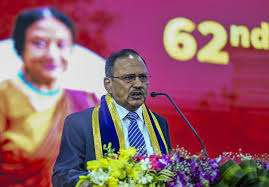‘You tell me, 1 photograph, 1 imagery which shows…’: Ajit Doval flags lack of proof of damage on Indian side during Operation Sindoor

National Security Advisor (NSA) Ajit Doval recently issued a strong statement about the alleged damage to Indian forces during Operation Sindoor. The operation was launched to counter terrorism and secure the India-Pakistan border. Since then, it has sparked much debate in political and media circles. However, Doval pointed out that no credible evidence—like photos or satellite images—shows any damage on the Indian side.
Background: Operation Sindoor and Its Strategic Importance
Operation Sindoor aimed to stop cross-border terrorism and protect India’s territorial integrity. It took place in sensitive border areas and targeted militant activities. Indian security agencies have called the operation a tactical success. Despite this, some critics questioned if Indian forces suffered losses or damage.
Ajit Doval’s remarks clarify the government’s stance on these doubts. He is known for his deep knowledge of India’s national security and strategic planning.
Doval’s Challenge: No Evidence of Damage on Indian Soil
At a recent security conference, Ajit Doval directly challenged anyone claiming Indian damage during the operation. He said, “You tell me, one photograph, one imagery which shows damage on our side.” This challenge shows his confidence in the operation’s success. It also dismisses claims that lack proof.
In today’s world, satellite images and photos are widely used to verify military actions. The fact that none show damage on the Indian side weakens those opposing the government’s narrative. Doval’s words stress the importance of using verified intelligence over rumors or politically motivated claims.
Technology’s Role in Modern Warfare
Doval’s focus on photographic evidence highlights how technology shapes modern military operations. Today’s forces use high-resolution satellite images, drones, and other advanced tools to monitor borders and assess operations.
India’s agencies regularly employ such technology to detect infiltration and evaluate military outcomes. The absence of visible damage in these images likely means Indian forces avoided harm. Or it shows that claims of Indian damage are exaggerated.
This emphasis on reliable data also boosts India’s credibility internationally. Verified intelligence helps India counter misinformation and justify its actions.
Political and Media Reactions
Since Operation Sindoor began, some opposition parties and media outlets have speculated about its real cost. They questioned whether Indian forces faced casualties or damage. Ajit Doval’s statement serves as a rebuttal. He urges critics to provide hard proof instead of rumors.
Political rivalries often drive attempts to question national security efforts. Doval’s challenge puts the responsibility on those critics. They must back their claims with evidence.
Strategic Messaging and Public Confidence
Senior officials like Ajit Doval use public statements to shape the narrative around security. By demanding proof, the government reassures citizens about the strength of its forces.
Public trust is vital in national security matters. Confidence in the military boosts morale and unity. Doval’s clear message—that no evidence shows damage on the Indian side—helps maintain that trust. It also curbs rumors that could harm public confidence.
Verified Information in Conflict Zones
The India-Pakistan border is an area filled with misinformation and conflicting stories. Both countries often accuse each other of twisting facts for political gain. In this environment, verified information is crucial.
Doval’s insistence on evidence encourages a focus on facts. He calls on media and the public to avoid sensationalism. This approach follows global standards for conflict reporting and accountability.
Future Implications for India’s Security Strategy
Operation Sindoor will be seen as a key example of India’s evolving border management. Conducting such operations without suffering damage shows improved training and readiness.
The government’s openness about operation results sets a positive example. It shows India is ready to face scrutiny and engage critics with facts.
For security experts, Doval’s remarks underline the need to invest in surveillance and intelligence tools. In modern warfare, data and imagery are as important as troops on the ground. Maintaining superiority in these areas is critical for India’s safety.
Conclusion
National Security Advisor Ajit Doval’s remarks on the lack of photographic or satellite proof of damage during Operation Sindoor serve several purposes. They confirm Indian forces’ success and safety. They challenge critics to back their claims with evidence. And they highlight the key role of technology and verified intelligence in modern military operations.
In a world of competing narratives and information warfare, Doval’s stance promotes transparency and fact-based discussion. As Operation Sindoor’s effects continue to unfold, the demand for credible evidence remains central to understanding India’s security actions.






